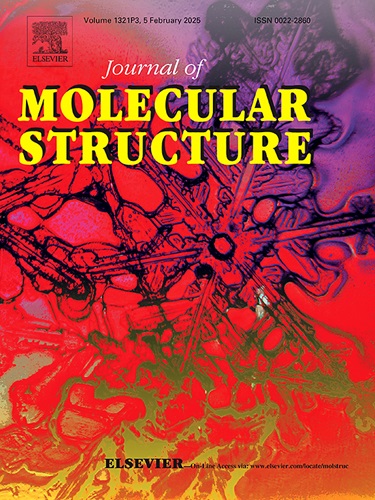A balance in SHG response, band gap and birefringence in a series of rare-earth sulfate-iodate
IF 4.7
2区 化学
Q2 CHEMISTRY, PHYSICAL
引用次数: 0
Abstract
Second harmonic generation (SHG) response, birefringence, and optical band gap are several critical parameters of nonlinear optical (NLO) crystals. However, due to the mutual influence and constraints among the fundamental properties of NLO crystals, simultaneously optimizing these performance parameters poses a significant challenge. Herein, lanthanide iodates crystallizing in centrosymmetric (CS) space group were selected as parents, by introducing [SO4] group and water molecule to induce symmetry breaking, a series of mixed-anion lanthanide iodate-sulfate hydrates, RE(IO3)(SO4)(H2O)2∙H2O (RE = Eu, Gd, Tb, Yb, Y), were obtained. Their structures changed from the CS space group of the parents to non-centrosymmetric (NCS) one (P212121). These crystals exhibit strong SHG responses (0.79−1.21 × KH2PO4), moderate birefringence (0.061−0.109), short UV transmission cutoff edges (∼240 nm), and wide optical bandgaps (4.24−4.32 eV), demonstrating their potential as NLO crystalline materials with excellent comprehensive properties. This work highlights a feasible strategy of introducing [SO4] group and water molecule into CS iodates to construct NCS structures, thereby developing potential high-performance NLO crystal materials.

一系列硫酸盐-碘酸稀土中SHG响应、带隙和双折射的平衡
二次谐波产生(SHG)响应、双折射和光带隙是非线性光学晶体的关键参数。然而,由于NLO晶体基本性质之间的相互影响和制约,同时优化这些性能参数是一个重大挑战。本文选择在中心对称(CS)空间群中结晶的碘系镧为亲本,通过引入[SO4]基团和水分子诱导对称性破缺,得到了一系列混合阴离子型碘系镧-硫酸盐水合物RE(IO3)(SO4)(H2O)2∙H2O (RE = Eu, Gd, Tb, Yb, Y)。它们的结构由亲本的CS空间群转变为非中心对称(NCS)空间群(P212121)。这些晶体具有较强的SHG响应(0.79 ~ 1.21 × KH2PO4),中等双折射(0.061 ~ 0.109),较短的紫外透射截止边(~ 240 nm)和较宽的光学带隙(4.24 ~ 4.32 eV),具有优异的综合性能,显示出作为NLO晶体材料的潜力。本研究提出了将[SO4]基团和水分子引入CS碘酸盐中构建NCS结构的可行策略,从而开发出具有潜力的高性能NLO晶体材料。
本文章由计算机程序翻译,如有差异,请以英文原文为准。
求助全文
约1分钟内获得全文
求助全文
来源期刊

Journal of Molecular Structure
化学-物理化学
CiteScore
7.10
自引率
15.80%
发文量
2384
审稿时长
45 days
期刊介绍:
The Journal of Molecular Structure is dedicated to the publication of full-length articles and review papers, providing important new structural information on all types of chemical species including:
• Stable and unstable molecules in all types of environments (vapour, molecular beam, liquid, solution, liquid crystal, solid state, matrix-isolated, surface-absorbed etc.)
• Chemical intermediates
• Molecules in excited states
• Biological molecules
• Polymers.
The methods used may include any combination of spectroscopic and non-spectroscopic techniques, for example:
• Infrared spectroscopy (mid, far, near)
• Raman spectroscopy and non-linear Raman methods (CARS, etc.)
• Electronic absorption spectroscopy
• Optical rotatory dispersion and circular dichroism
• Fluorescence and phosphorescence techniques
• Electron spectroscopies (PES, XPS), EXAFS, etc.
• Microwave spectroscopy
• Electron diffraction
• NMR and ESR spectroscopies
• Mössbauer spectroscopy
• X-ray crystallography
• Charge Density Analyses
• Computational Studies (supplementing experimental methods)
We encourage publications combining theoretical and experimental approaches. The structural insights gained by the studies should be correlated with the properties, activity and/ or reactivity of the molecule under investigation and the relevance of this molecule and its implications should be discussed.
 求助内容:
求助内容: 应助结果提醒方式:
应助结果提醒方式:


